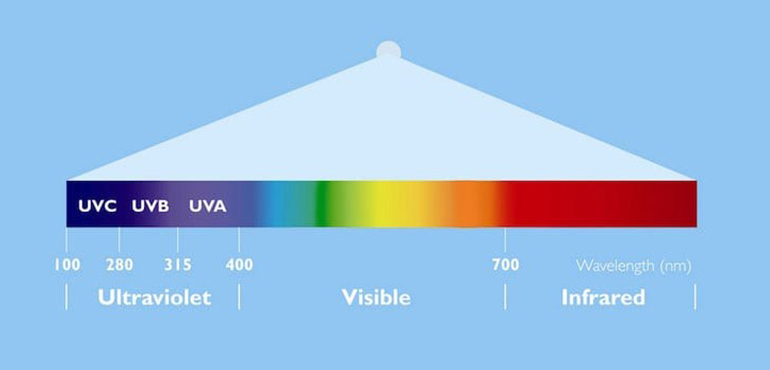
What is ultraviolet ray? Where to use?
UV rays are rays in the electromagnetic spectrum with a wavelength in the range of 10 – 400 nm. 1 nm = 10-9 m, that is, it is one billionth of a meter. The human eye can see the wavelength range of 400-800 nm. UV rays remaining in the region below the 400 nm limit cannot be detected by the human eye.
UV rays are separated according to their wavelength.
UVA (315 – 400 nm)
UVB (280 – 315 nm)
UVC (100 – 280 nm)
MUV (200 – 300 nm)
VUV (10 – 200 nm)
X-rays with a wavelength range of 0.1-10 nm slightly below the UV region are also called X-rays. The rays in this area are used in the medical imaging field.
The frequencies and total energies of UV rays, whose wavelengths are shorter compared to the rays in the visible region, are also higher. UV rays with an energy of more than 10 eV and a wavelength below 125 nm have the energy to ionize hydrogen and oxygen atoms. These rays can harm human health. Depending on the duration of exposure, they can cause ailments such as sunburn and skin cancer in the human body. Low doses of UVB rays are necessary to produce the vitamin D people need. Approximately 10% of the radiation emitted by the sun, whose outer surface has a temperature of approximately 5800 K, is in the UV region. The ozone layer in the stratosphere layer of the atmosphere passivates all of the rays in the UVC region and most of the rays in the UVB region, preventing these harmful rays from reaching the world.
The use of protective creams by people under sunlight is for protection from UV rays.
Although the atmosphere destroys all of the UVC rays reaching the earth from the sun, and most of the UVB rays, the limited part of the sunlight that can reach the earth in the wavelength range of 290-320 nm is useful for microbe deactivation.
The amount of sunlight containing UV rays with a wavelength of 290-320 nm varies according to the falling angle of the sun rays, the season, the height of the region, the time of day and the momentary change in the ozone layer.
Selection of the UV light source
In UV sterilization applications, the power and wavelength of the light source to be used is a design parameter that should be selected according to the project.
In order to obtain high UV sterilization efficiency, it is necessary to accurately determine which optical power and which wavelength UV light will be selected, how it will be mounted, how long the sterilization distance and application time will be.
In order to measure the success of sterilization efficiency, samples taken before and after the process are compared in the laboratory environment. Results are compared logarithmically. The percentage of success in sterilization is calculated by determining how many microorganisms have been destroyed and how much remains.
With the formula of total UV optical power / surface area reaching the material, the UV light flux on the material is calculated and expressed in W / m2 unit. By multiplying the light flux by the application time, we can calculate the total UV dose received by the material, ie the amount of UV energy applied per unit area in J / m2.
Determining the amount of UV light dose required to obtain a specific log reduction factor on a microorganism-coated surface should be considered an important research topic.
Use of UV rays in central air conditioning systems
Ultraviolet rays are used in central air conditioning systems. In order to obtain high efficiency from UV beam systems to be used in central air conditioning or central ventilation systems, design should be made by taking into account the calculation procedures including factors such as size, flow rate, power, efficiency percentage, beam selection.
It should not be forgotten that the UV ray system to be applied to air handling units or fresh air plants is effective only in the area where it is reflected. The UV light system applied inside the central ventilation units will have a weak effect on the indoor air and indoor surfaces. In other words, the UV light system applied inside the central ventilation units will be insufficient to purify the indoor air and indoor surfaces from bacteria and viruses.
In order for central air conditioning or central ventilation systems to be effective in completely purifying the indoor air and bacteria and viruses that occur on the indoor surfaces, industrial ozone units must be used.
For detailed information on the use of ozone in central air conditioning systems, you can visit https://www.alperen.com.tr/urunler/endustriyel-ozon-sistemleri/.
The use of UV rays in personal belongings
Do you know that ultraviolet rays and ozone have a destructive effect on all known viruses, bacteria, fungi, yeasts and molds? In many international academic studies, it has been predicted that the disinfectant effect of ultraviolet rays and ozone can be used to destroy bacteria and viruses. Ultraviolet rays and ozone gas are much stronger than other disinfectant methods. The surfaces of any object treated with ultraviolet light and ozone are cleaned from viruses, bacteria and similar microorganisms in a short time.
With Alp UVX03 series ultraviolet units designed and manufactured by Alperen Engineering, your body care tools, make-up materials, kitchenware, toothbrushes, scissors, wallets, mobile phones, laptops, calculators, maus, remote controls, office tools, cargo bags, your money. , your glasses, pens, bags, keys, masks, gloves, rings, earrings, toys, food bowls of your dear friends, all accessories and items that come into contact with your body, you can immediately purify from bacteria and viruses.
You can use Alp UVXO3 series portable ultraviolet units in hospitals, pharmacies, doctor’s offices, clinics, shopping centers, plazas, workshops, markets, offices, restaurants, residences, workplaces, kindergartens, nurseries, educational institutions, gyms, hairdressers, beauty centers. .







